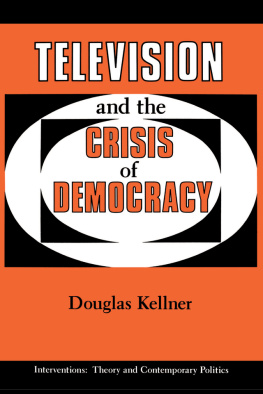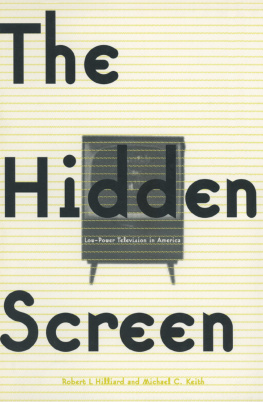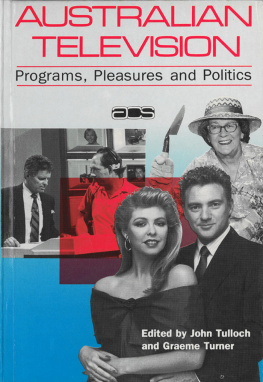ROUTLEDGE LIBRARY EDITIONS: TELEVISION
Volume 17
THE USE AND ABUSE OF TELEVISION
THE USE AND ABUSE OF TELEVISION
A Social Psychological Analysis of the Changing Screen
J. MALLORY WOBER
First published in 1988
This edition first published in 2013
by Routledge
2 Park Square, Milton Park, Abingdon, Oxon, OX14 4RN
Simultaneously published in the USA and Canada
by Routledge
711 Third Avenue, New York, NY 10017
Routledge is an imprint of the Taylor & Francis Group, an informa business
1988 Lawrence Erlbaum Associates, Inc.
All rights reserved. No part of this book may be reprinted or reproduced or utilised in any form or by any electronic, mechanical, or other means, now known or hereafter invented, including photocopying and recording, or in any information storage or retrieval system, without permission in writing from the publishers.
Trademark notice: Product or corporate names may be trademarks or registered trademarks, and are used only for identification and explanation without intent to infringe.
British Library Cataloguing in Publication Data
A catalogue record for this book is available from the British Library
ISBN: 978-0-415-82199-5 (Set)
eISBN: 978-0-203-51517-4 (Set)
ISBN: 978-0-415-83953-2 (Volume 17)
eISBN: 978-0-203-76997-3 (Volume 17)
Publisher's Note
The publisher has gone to great lengths to ensure the quality of this reprint but points out that some imperfections in the original copies may be apparent.
Disclaimer
The publisher has made every effort to trace copyright holders and would welcome correspondence from those they have been unable to trace.
The Use and Abuse
of Television
A Social Psychological
Analysis of the Changing Screen
J. Mallory Wober
Copyright 1988 by Lawrence Erlbaum Associates. Inc.
All rights reserved. No part of this book may be reproduced in any form, by photostat, microfilm, retrieval system, or any other means, without the prior written permission of the publisher.
Lawrence Erlbaum Associates, Inc., Publishers
365 Broadway
Hillsdale, New Jersey 07642
Library of Congress Cataloging-in-Publication Data
Wober, J. M. (J. Mallory)
The use and abuse of television.
Bibliography: p.
Includes Index.
1. TelevisionPsychological aspects. 2. Television broadcastingSocial aspects. I. Title. II. Title: Social psychological analysis of the changing screen. PN1992.6.W65 1988 302.2345 88-3819
ISBN 0-89859-662-9
Printed in the United States of America
10 9 8 7 6 5 4 3 2 1
Contents
Chapter 1
The One Hand Clap? Or a Sounder Way of Understanding Television
Chapter 2
The Drive-In Screen and What People Will Pay to Entertain It
Chapter 3
Types of Programs as Produced, Partaken, and Perceived
Chapter 4
Challengers: Opponents of the Screen Itself or of Its Contents
Chapter 5
Champions: The Prophets of the Power of the Screen
Chapter 6
The Changing Screen and a Changing Viewer
Chapter 7
To Zion or Gomorrah: The Highway of the Screen
The One Hand Clap? Or a Sounder Way of
Understanding Television
INTRODUCTION: EXPLORING THE NATURE
OF THE SCREEN AT HOME
Capping his illustrious career, Hugh Malcolm Beville (1985)whom we shall encounter againwrote a stirring and definitive defense of some of the ways in which American television is assessed. After long service with NBC and a full academic professorship, Beville served as Executive Director of the Broadcast Rating Council (which later evolved into the Electronic Media Research Council). Referred to as the dean of broadcast research, Beville has a clear and probably uniquely well-informed view of the scene. In a telling anecdote, which he draws from a Carnegie Commission report on the Future of Public Broadcasting, (Beville, 1985, p. 234) he recounts:
At the end of a concert at Carnegie Hall, Walter Damrosch asked Rachmaninoff what sublime thoughts had passed through his head as he stared out into the audience during the playing of his concerto. I was counting the house, said Rachmaninoff. The principal test of public broadcasting's accountability to the community is whether anybody is listening or watching.
To take Rachmaninoff s remark at face value tells us only that Damrosch had had his leg pulled; to draw the conclusion that is contained in the final sentence, the passer-on of this tale Gary Steiner (1965) shows that he may have as shallow an understanding of creative musicians as he has a command of logical inference.
In this book we hope to maintain an appreciation of humor but also to be careful about conclusions and the processes by which they are attained. To illustrate this claim, let us ask some questions about the anecdote. Can Rachmaninoff have been right in implying that his assessment of events stopped short at a count of listeners? This may be partly true but is unlikely to be the whole or even the most important part of the truth, for musicians pay great attention to the applause at the end of a performance. This not only reflects their own concern about their product, but it also gives them a good idea about what the size of the house may be next time and whether they will have to face their peers, their managers, and their own creative selves with confidence or with contrition.
If one accepts that public broadcasting is best assessed by the size of the house then one might develop either of two approaches at PBS in the United States or at the BBC and IBA in Great Britain, neither of which is actually in practice. One would be to close down the PBS under the assumption that the public is better served by existing commercial and cable services. A second approach would program, as other networks do, soap operas, talk and game shows to maximize public broadcasting's share. Of course, these are not the aims of public broadcasting, nor is the best test of public broadcasting's accountability the achievement of some arbitrarily set quorum of audience size.
Before we leave this anecdote, it is important to pay attention to what Walter Damrosch had done. Damrosch did not find out the size of the ticket paying audience and start a conversation with Rachmaninoff on this basis; he treated the musician as audience, as a viewer, and to assess his (Rachmaninoff's) experience, he asked him what was in his mind. This fact should be the first lesson drawn from the anecdote. That a highly selective interpretation has been placed on the outcomethat skill and caution have to be used in dealing with subjective responses and expressionsshould be the second lesson. In fact, this applies as well to objective data, which can be equally misleading if treated carelessly.
Thus far, we have encountered two ways of assessing an audience. One is simply by noting its size. Of course, this is more easily done in the concert hall or theater, though even there one has to be careful with mere numbers. Often tickets are given away to fill the house and thereby generate enthusiasm. Also, package or season sales of tickets can produce larger audiences than might have been achieved for certain shows if they had had to compete on their own account. A more accurate way of appraising a show is by asking the audience how they liked it or, as in the theater where a routine occasion has been established for this purpose, by noting the nature of the applause (or catcalls). We are not concerned in this book, however, only with assessing an audience; we wish to gain an understanding of the Screen At Homea much broader problem. To do this, we will look more deeply into the phenomenon most widely called television (literally, meaning far-seeing, just as, in German it is called fernsehen, although the viewer does not see anything far away screens are all too often positioned unhealthily closeand the term does not logically exclude video-cassette viewing, or teletext). For practical purposes, television can be understood as the home screen that is used for viewing picture programs. These may have been broadcast, brought by cable, carried on cassette, or rarely, even made by oneself with a videocamera (hardly tele, or fern). In English speaking countries, television services were inaugurated in 1936 (BBC in London) and in 1939 (RCA/NBC at the New York World's Fair); however, the war and the heyday of radio briefly stood in television's way.






